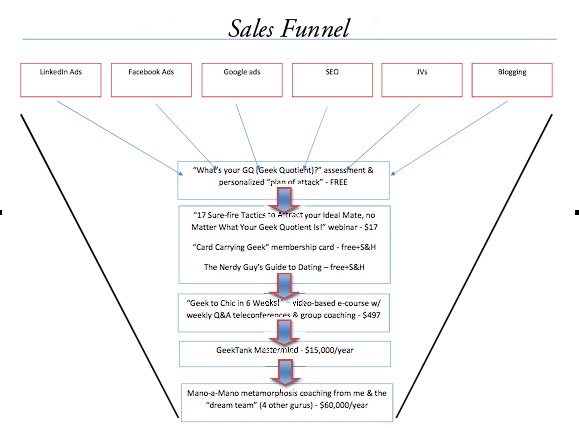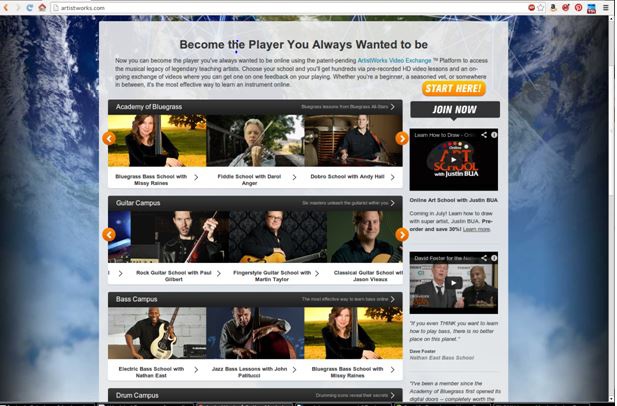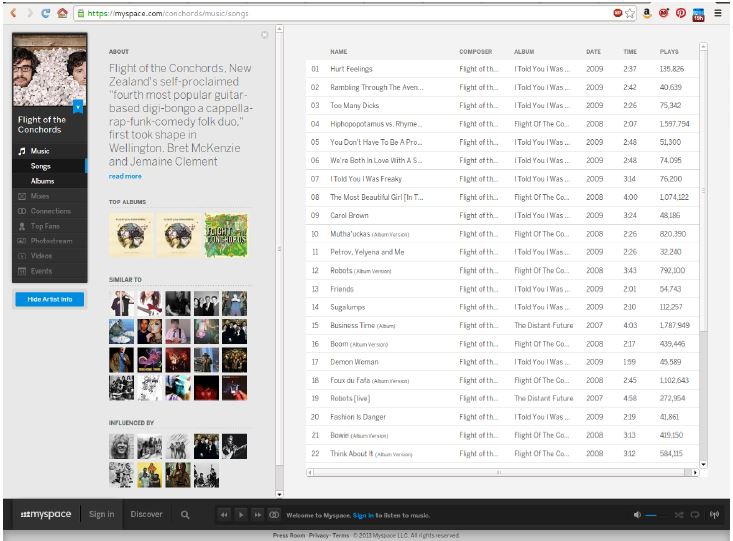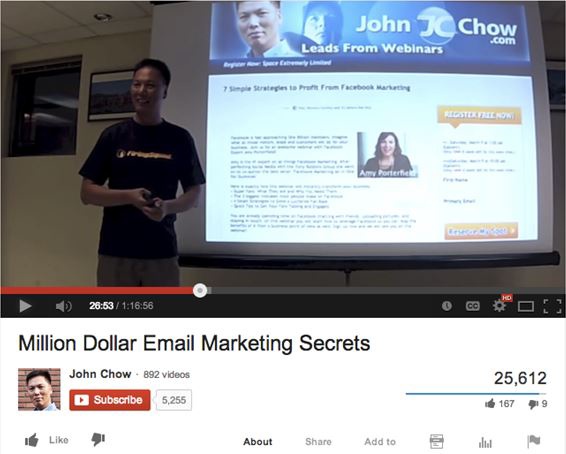Chapter 4. Marketing Strategy: Digital Goods and Services
If you just read Chapter 3, there probably isn’t going to be much in this chapter that is useful to you. In fact, some of the information here could be harmful, if applied, because it is geared toward a completely different market than the advice in Chapter 3. If your ecommerce business is not selling digital goods and services (such as webinars, ebooks, software licenses, online media streaming, etc.), then skip this chapter and head to Chapter 6 to get a comprehensive education on ad design and testing.
In the beginning of this book, we said that a successful strategy has three components: intention, context, and tactics. This is why we have separated the sale of digital goods and services—things that are delivered and consumed digitally—from the sale of other sorts of things. There is a low barrier to entry for this kind of sale compared with other categories. This is where impulse buys thrive, and viral marketing can bring a tidal wave of sales.
The key to successful ecommerce sales is driving prospects to opt in, partake in free samples, and make impulse purchases. You can use these separately or combine them. We’ll get into the details for both of these approaches in this chapter.
Let’s start with Figure 4-1, which shows a sales funnel as a visualization and planning guide for your business.
Leads come into the top of the funnel through advertising and marketing channels such as Facebook ads, Google ads, SEO, radio ads, billboards, etc. At the top of the funnel is a lead magnet. This has to be an irresistible offer, basically an ethical bribe. In exchange for someone’s name and email, you’re offering this great piece of information. It can be a report, video, or downloadable tool—ideally something that is consumed in 5–10 minutes maximum. If it is longer than that, the person will feel obligated to wait until she has time to consume the whole thing, which can slow the sales process.
Next in the funnel is the tripwire. A tripwire is a low-cost physical or virtual product that is offered to clients. It can be a book that is free (other than shipping and handling), or an online lesson or webinar for a low amount of money. As an example, say you sell guitar lessons. A great tripwire would be a low-cost lesson on how to play the F chord, since it is difficult for learners. Once people are pleased with the result they got from the tripwire, they are more likely to buy the core product. Frank Kern calls this “results in advance.” This “trains” people to get used to spending money with you. Essentially, you are creating a list of buyers. Consider making your tripwire a physical product that you ship. Nobody wants to go all the way to the post office to return an item just to get a few dollars back.
Automation is so important in this step. Although this is the lowest amount of profit, this step is critical in warming up a list of buyers for your core product and for profit maximizers. But you don’t want to waste talent on the low tiers of profit, you want to use it on the narrower end of the funnel. This is where automation comes in. If your tripwire is something like a webinar, using automated emails or texts as reminders can dramatically increase the show rate for webinars (which is usually less than half of the sign-up rate).
The core product is the next thing in the funnel. This could be a $97 ebook, a $200 video-based course, or something else in that higher price range.
Profit maximizers are at the small end of the funnel. They could be a live event, a group coaching program, or a yearlong mastermind program. If you don’t sell profit maximizers, only your core product, you’re leaving on the table easily half the amount of money that you could potentially make.
Change one-on-one consulting into a group coaching model. This means moving from addressing individuals by one person at a time through your product, to addressing an entire group simultaneously. Because you are addressing all of your clients at once, this is the most fiscally smart and time wise option. It allows you to achieve scale.
Digital Goods and Services That Do Well on Social Media
No matter what you’re selling, a good social media presence will help you in some way—direct sales, customer service, or brand awareness. In our combined experience, though, companies in these industries see a much more significant sales increase through social media:
- Books (links to Amazon/Audible; this is a grey area in terms of strategy because you probably aren’t doing the fulfillment yourself)
- “Daily deals” sites, such as Groupon, AppSumo, LivingSocial, and Restaurant.com
- Apps—for mobile, Facebook, or browsers
- Bands and music promotion
- Games
- Software
- Video services (such as music lessons)
- Online coaching
- Webinars
The Right Intent
Being successful on social media means engaging people with interesting content. You must start with this mindset; if you don’t, you’ll default to “sales mode,” and be ignored by the people you’re spending time and money to reach. Social media is where people go to hang out and have fun with their friends. That makes it a bad environment for selling stuff—everyone is focused on the content, not the sales pitches—so work with that instead of against it. Here are some guidelines for staying in the right frame of mind:
- Bigger isn’t better.
- You don’t need tons of fans to make sales. Social media engagement is definitely a “quality over quantity” situation. Overlook the vanity metrics: likes, fans, friends, and followers. Instead, focus on the actions that drive sales.
- Incorporate ratings and reviews on your sales pages.
- Make them prominent. This is an excellent way to get simple, introductory engagement.
- Reward people for referrals and recommendations.
- Figure out why your current customers recommend you, and start using this information to assist with your sales follow-ups.
- Engage.
- Look for a problem you can solve and a question you can answer, and send a relevant, helpful response.
- Listen.
- Look for buying signals: questions, concerns, and complaints.
- Be authentic.
- Show the real you with photos of yourself, your staff, and your office. Show that you’re a real business by posting videos of your office or studio.
Hopefully, you didn’t expect to just sign up on Facebook, post a few marketing messages, and kick back to watch the orders pour in. If so, if our advice up to this point hasn’t sunk in then now’s the time to sober up.
You have to do more than post messages on social media. That serves a purpose and it is important, but it’s not the whole plan. To turn more friends and fans into customers, you’ve got to create plenty of content to support the sales process. That means product tutorials and demos, case studies of success stories, newsletters, updates, niche landing pages, in-person events, conference attendance coverage and reports, blog posts, and podcasts—in other words, education-based marketing.
Since “digital fulfillment” goods are pretty much exclusively marketed online, you should already be familiar with the fundamentals of online sales and marketing. Think of Facebook as an extension of your other online advertising efforts, to a certain extent. Beyond that, social media is more about awareness and promotion. If you have a new product and want to get maximum exposure for it, a contest or giveaway on social media will work marvelously—better and more cheaply than any traditional AdSense or DoubleClick campaign.
You should have an idea of whether your products are “impulse buy” material or not. If they are inexpensive and either very cool or very necessary, then they’re impulse buys. If that’s the case, before you start your social media campaign, you must streamline your sales process to make it as effortless as possible. If you can complete the sale in one click (via PayPal or Google Wallet or Amazon Payments), then do it. Every extra step in the sales process loses sales for you.
If you’re not in the “impulse buy” category, then you need to give away free stuff. Excerpts, free trials, free videos (if there is a series you’re selling), and limited-use licenses are all examples. This helps establish the quality of the paid products. Use that free trial to show how “worth it” the rest of the product is.
If you have multiple products, you can heavily promote one of them for free and use it to advertise the others. There are many different tactics for this, depending on your industry.
Last but not least is freemium—free for most functionality, but costs for the really good stuff. Words With Friends, for instance, is free to play, but to remove the ads and get the extra “pay to win” features, players have to pay. Since the game is connected through the app stores of the platforms it’s on, it’s a low-barrier sale that is quick and easy to complete. It’s a perfect example of freemium in action.
If you are above the impulse buy threshold, fall back to the opt-in. You can combine this with the free-stuff approach by offering the free stuff only after a very simple opt-in form. Just a name and an email address and one more click to the free stuff. A great example here is ArtistWorks (shown in Figure 4-2), which offers interactive video lessons for a variety of musical instruments. Each product page shows the pricing plans up front, with an introductory video and a quick opt-in form to access some free lessons. The real value isn’t so much the lessons as it is the video interaction and feedback from the teacher, so there’s quite a lot of free content on the site after the opt-in, while the true value of the paid service is made quite clear. The first opt-in email ArtistWorks sends comes from the VP of Marketing’s own email address, and he encourages you to reply to him directly with the answer to the prompt: “I would love to know WHY you want to improve your playing NOW.” If you reply, he responds. Not only is this a friendly interaction with the company, but it also gives the company direct feedback on how to improve future marketing efforts. The entire operation is brilliantly combined with giveaways and other promotions through magazine ads and social media posts.
James Schramko is also a genius at using the free stuff approach to draw more attention to his paid services. He has many different products that all complement one another. In his podcasts for one of those products, he’ll casually mention the others without explaining them so that you’re forced to look them up on your own. Curiosity is a fantastic way to drive traffic.
Forming a Superior Strategy
Now that you’ve established proper context and intention for the sale of digital products and services on social media, it’s time to commit to a plan. Use this list as a framework for your strategy:
- Define your sales funnel.
- That includes your lead magnets, tripwires, core product, and profit maximizers.
- Prepare your landing pages.
- Don’t start marketing until your sales infrastructure is ready. Make sure all of your ducks are in a row on your online store. Remember to calibrate your landing pages to do either a low-friction impulse buy or an opt-in with free stuff. Optimize your landing pages for maximum conversion. LeadPages is a great service that can make high-converting landing pages for acquiring opt-ins and registrations for newsletters, Google Hangouts, webinars, and all sorts of other cool stuff you might be offering. One thing that sets LeadPages apart is its unique “lead box” feature. Basically it’s a sign-up button with instant access. There are no name or email form fields to fill out until you click the button, then a pop-up/overlay appears with a small form to fill out. This increases signup by changing the landing page from a “taking” page (a demand for data from the prospect) to a “giving” page. Visitors are promised information, resources, and answers. Once they click the button and get the pop-up asking for their name and email, they are already mentally committed.
- Set goals and checkpoints.
- How many sales and/or referrals is it reasonable to expect from your social media work? This is a hard question to answer accurately. Try to choose a conservative estimate so that you aren’t discouraged with sluggish results. Some markets can be slow to reach, and will take more effort over a longer period of time. It might be more useful to set a goal to get more social media traffic to your landing pages; the conversion work happens outside of social media.
- Make a content plan.
- We published a good content plan in Chapter 2 that you can easily adapt for your market. You must have some kind of plan for how things are going to play out. For instance, it does no good to offer an amazing deal if you just set up your Facebook page 10 minutes ago. You need an audience first, and then you need some engagement, and then you can push it over the edge with a special offer or giveaway.
- Establish a presence.
- Identify the social networks that you’re prepared to maintain a presence on, and set up your pages there. Make sure each page is fully customized and has a good account name that represents you properly.
- Build a “starter” audience.
- Advertise and promote your social media pages to build an audience. Only you can determine how much is a good minimum target. It may be 500 Twitter followers, or 1,000 Facebook likes. This is just the beginning—what you jumpstart your social media marketing effort with. This number is not the endgame goal. You should have some good starter content to post as well; this might be a good time to release some of your supporting material—the how-to guides and other ancillary marketing materials that you will offer on a permanent or long-term basis—or begin promoting your free stuff.
- Execute your content plan.
- Start posting on the schedule that you’ve laid out for yourself. Your content plan might allow for a minimal audience at first, so you don’t necessarily have to wait until you have your target “starter” audience in order to start posting.
- Increase engagement.
- Now that you’re up and running, the stats and feedback should have some hints as to what kind of content is and is not working. Streamline your efforts, adjust your content plan, and advertise and promote to gain maximum engagement (not maximum likes/fans—you only want good leads at this point).
Site-Specific Tactics
Now that you have a plan, you must identify tactics to help you achieve it. We’ve already covered the basics in Chapter 2, but now we’re going to get more specific for your industry segment.
When it comes to selling digital goods and services, you want to put effort only into the networks that are going to give you the highest level of engagement. Niche networks are probably not going to help you achieve your goals, though there may be some exceptions in outside cases. For the most part, you’re going to want to stick to the big social networks.
Facebook works really well for impulse buy products (low-cost, high-need). It’s also a good way to advertise specials and deals. You can maximize the effectiveness of a “deal” announcement on Facebook by clearly showing the benefit, discount, and urgency of the deal. For instance, a webinar service that is usually $150 per month is available today only for $75 for a lifetime membership.
Bands and musicians can do well on Facebook through promo clips on YouTube, prerelease tracks, contests, ticket sales, events as concerts, and show announcements through highly targeted local advertising.
Pinterest has quickly become essential for business owners, because it is great for posting wares, developing a brand, and establishing a following. Pinterest isn’t necessarily the place for deals, but it still touts impressive stats. According to a 2012 study done by BloomReach, Pinterest converted to sales 22% more than Facebook did. Also, Pinterest traffic spent 60% more than Facebook traffic did. Keep those numbers in mind.
Twitter is useful for customer service, brand/product awareness, and deal announcements, but only if you have a decent number of followers. It’s more time-consuming to build a Twitter following than it is a Facebook following, but you have a much greater opportunity to reach a lot of people with impulse buy deals. Twitter is ephemeral; it’s here one minute, gone the next. People who see a limited-time–deal announcement on Twitter may be more inclined to jump on it right now than any other social network.
MySpace
Whoa, MySpace?! Blast from the past, eh? Yes, MySpace still exists, and is either on its comeback tour or playing for “pass the hat” tips at rundown clubs. No way to tell where it’s going at this point. However, the only thing MySpace has consistently been good at is promoting music, and Justin Timberlake’s guidance behind this network may eventually make it the Web’s social hub for new music. If you are serious about promoting your band or album, MySpace is worth a look. It doesn’t take much effort to establish a basic presence by setting up a page and uploading the songs that you’re willing to give away for free on a promotional basis. The same rules apply here as everywhere else: post interesting things (not just promotional material), and engage with people constantly. (See Figure 4-3.)
YouTube
How-to videos are great for tutorials for software and games. If you’re selling a video series or an album, it might make sense to put your freebie content on YouTube and heavily promote it there rather than on your main site. First of all, you’ll save on bandwidth, which could otherwise be a substantial cost if your video goes viral. Secondly, you’ll be able to leverage YouTube’s social features—such as commenting, favoriting, liking, subscribing—boosting these engagement metrics will help your YouTube search rankings.
Music and concert videos for bands are also great YouTube material.
Professional blogger and business guru John Chow is one of the kings of educational marketing to Internet entrepreneurs. Figure 4-4 shows a screenshot of one of his YouTube videos.
Summary
We hope this chapter has helped you to think holistically about social media. Of all the reader segments we wrote this book for, yours is the one that probably has the most experience in online marketing. That’s a blessing and a curse; you’re familiar with the game, but you have probably been playing at least some part of it in an inefficient way until now, and it’s going to be tough to change some of the initiatives that are already in motion and modify habits that you didn’t know were bad.
At this point, you might want to stop and reflect on what you’re doing, why you’re doing it, and what you should change in order to achieve your goals. Don’t make any big changes just yet—start with small but important adjustments.
In our experience, defining an effective sales funnel can be an epiphany for struggling digital entrepreneurs. Even those who are aware of it aren’t always optimizing all stages in the funnel for maximum effect. This might be a good place to start if you’re redesigning your online marketing strategy.
Chapter 6, which covers social media advertising, should be your next stop. Chapter 5 is customized solely for entrepreneurs who have a local storefront.
You can also head over to the Social eCommerce site for more Q&A and to post your own burning questions! You’ll have access to exclusive offers, discounts, and coupon codes on various social media tools and services.
To get exclusive access to instructional videos related to the concepts in the chapter, simply send a text with your email address to +1(213)947-9990 and we’ll send you some great links.
Get Social eCommerce now with the O’Reilly learning platform.
O’Reilly members experience books, live events, courses curated by job role, and more from O’Reilly and nearly 200 top publishers.





